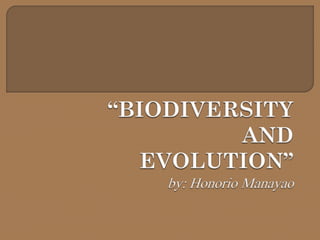
BIODIVERSITY:EVOLUTION
- 2. Five types of evidence for evolution are discussed in this section: ancient organism remains, fossil layers, similarities among organisms alive today, similarities in DNA, and similarities of embryos. Another important type of evidence that Darwin studied and that is still studied and
- 3. The fossil record provides snapshots of the past that, when assembled, illustrate a panorama of evolutionary change over the past four billion years. The picture may be smudged in places and may have bits missing, but fossil evidence clearly shows that life is old and has changed over time.
- 5. Some examples of impressions are the trace fossils such as footprints, traces, remains of tunnels left by burrowing organisms, fossilized excrement's, and the holes made in shells by parasites. Impressions usually occur in fine-grained sediment such as clay or silt.
- 6. A compression fossil is a fossil preserved in sedimentary rock that has undergone physical compression. ... Compression fossils are formed most commonly in environments where fine sediment is deposited, such as in river deltas, lagoons, along rivers, and in ponds.
- 7. ❖An invertebrate, it lived in a shallow marine environment during Ordovician and Silurian
- 8. Crinoids look like plants but are actually animals related to our modern day starfish. They belong to Phylum
- 9. Dinosaur or giant reptiles ruled the earth during the Jurassic Period
- 10. This fossilized leaf is once apart of an early vascular plant during the Carboniferous Period.
- 11. Scientists combine several well- tested techniques to find out the ages of fossils. The most important are: Relative Dating, in which fossils and layers of rock are placed in order from older to younger. Radiometric Dating, which allows the actual ages of certain types of rock to be calculated.
- 12. The geologic time scale (GTS) is a system of chronological dating that relates geologica l strata (stratigraphy) to time. It is used by geologists, paleontologists, and other Earth scientists to
- 13. Comparative anatomy is the study of similarities and differences in the anatomy of different species. It is closely related to evolutionary biology and phylogeny[1] (the evolu tion of species).
- 15. HOMOLOGOUS STRUCTURES may perform different functions in the species living in the different environment, or it may have same origin but different functions.
- 16. ANALOGOUS STRUCTURES are structures of unrelated species may evolve to look alike. Analogous Structure have similar function but different origin.
- 17. Structures that look similar, but are derived from convergent evolution, meaning that the two organisms displaying homoplasy do not share a common ancestor. Instead, they may have evolved in common environments and the traits arose due to natural selection.[4] This can be seen most prominently in species that have camouflage capabilities, like an insect that can look like a leaf, but has no photosynthetic capability
- 18. The presence of homologous structure is a strong indicator that the organism evolved from common ancestor. This type of evolution is called DIVERGENT EVOLUTION. Convergence is an increase similarities among the species derived from different ancestors as a result of similar adaptation to similar environment. In convergent evolution, analogous structures of unrelated organisms from different ancestors develop similar function such as butterfly wings and bird wings.
- 21. An embryo is an early stage of development in organisms. The embryo of fishes, salamanders, lizards, birds, cats, and humans are similar during the first stage of their embryonic development; and have several homologous structures that are not present when the organisms are adults Embryonic development include stages such as blastula, gastrula, and organogenesis. Studies show that species that are closely related exhibit similar embryonic development. Even when in the adult stage, the organisms are
- 23. - was a French scientist who developed an alternative theory at the beginning of the 19th century. His theory centred on two ideas: the law of use and disuse. the law of inheritance of acquired characteristics.
- 24. Lamarck incorporated two ideas into his theory of evolution, in his day considered to be generally true. The first was the idea of use versus disuse; he theorized that individuals lose characteristics they do not require, or use, and develop characteristics that are useful.
- 25. Lamarckism (or Lamarckian inheritance) is the idea that an organism can pass on characteristics that it has acquiredduring its lifetime to its offspring (also known as heritability ofacquired characteristics or soft inheritance.
- 26. Charles Darwin is often cited as the greatest biologist in history. His most famous work, On the Origin of Species, explains the theory of evolution by natural selection, providing numerous supporting examples.
- 27. Darwin’s theory of evolution declared that species survived through a process called "natural selection," where those that successfully adapted, or evolved, to meet the changing requirements of their natural habitat thrived, while those that failed to evolve and reproduce died off. Through his observations and studies of birds, plants and fossils, Darwin noticed similarities among species all over the globe, along with variations based on specific locations, leading him to believe that the species we know today had gradually evolved from common ancestors. Darwin’s theory of evolution and the process of natural selection later became known simply as “Darwinism.”
